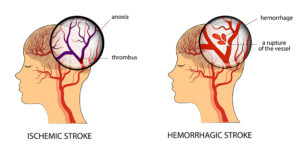Get answers

the information you need right now
TYPES OF STROKE
There are two types of stroke and each requires a different treatment. Your medical team must determine the type, ischemic or hemorrhagic.
Many hospitals use a telehealth system. The best stroke doctors in the country confer in a Zoom type meeting with your ER staff.
The types of stroke are ischemic, cutting off blood supply to brain tissue, or hemorrhagic, saturating brain tissue with blood.
IMPORTANCE OF DIAGNOSIS BEFORE TREATMENT
Brain tissue needs blood to live so a clot prevents the tissue from getting blood supply. The oxygen starved tissue starts to die in mere minutes so early intervention is critical.
Brain tissue cannot come into contact with blood or it will be damaged so stopping the hemorrhage is paramount to keeping tissue alive.
WHY NOT JUST ADMINISTER THE WONDER DRUG??
The miracle drug tPa is a clot busting drug. If an ischemic stroke is discovered within hours of onset, tPa may be given to dissolve the clot and restore blood flow.
Hemorrhagic strokes cannot have tPa. This is why diagnosis before treatment is so important.
If tPa cannot be administered, tests will be done to determine how to best treat the lack of blood flow.
There are different treatments for hemorrhagic strokes.
WHY IS DIAGNOSIS AND TREATMENT SO URGENT?
With both types of stroke, time is critical. If the stroke is not discovered right away, the list of treatment options diminishes considerably.
For untreatable or late discovery strokes, there may be nothing to do but wait 72 hours for the stroke to run its course.
Stroke outcome depends on how much tissue was damaged and the location of the damage. Each lobe has sections corresponding to body functions and motor/cognitive ability.
Interview with Critical Care Neurologist David Lin, MD courtesy of constanttherapyhealth.com
I’M YOUNG – HOW CAN THIS BE A STROKE?
Stroke isn’t just a senior affliction. Children and adults, male or female, smoker or non-smoker, issues with cholesterol, blood pressure, blood sugar or the picture of health – stroke is indiscriminate and caused by many unforeseeable factors in addition to the obvious reasons.
Once you are stable, your doctors will run tests to determine the cause of your stroke and refer you to the proper specialists upon discharge. You’ll likely go home with medication. If your stroke is severe, you may go to a rehab facility first.
WHAT WILL HAPPEN TO ME NOW?
“Every stroke is different”. Over time the truth of this seemingly generic cliche will become evident.
The type, location, length of time to treatment, success or lack of available treatment, co-morbidities and many other factors make each individual stroke unlike any other.
The only thing all strokes have in common – the brain has amazing capacity to build new neuron connections. That process is called neuroplasticity and is slow.
IS THIS WHAT THE REST OF MY LIFE WILL BE?
Spontaneous recovery is the period of time soon after your stroke. When brain tissue surrounding the core area of your stroke (penumbra or watershed) has oxygen supply restored to it, words or actions may spontaneously “come online” and return naturally.
You will find your baseline after spontaneous recovery slows down. That’s when you know the true extent of stroke damage and where your journey begins.
If your stroke was minimal in tissue damage, you might feel nothing more than tired and confused for a while.
If the damage was severe, the recovery may be frustrating, difficult and disheartening at times. You may never recover all of your functions or they may differ from pre-stroke.
HOW CAN I POSSIBLY RECOVER FROM THIS?
We’re here to help you with your recovery journey. We’re here to say there IS hope. Fight!
We’re in your corner.
Emergency Room
The most important part of treating a stroke is time. Doctors, nurses and technicians work to diagnose the type, cause and course of action.
Because time is critical, there’s not a lot of explaining to the family during this time.
Listen to Sandra Hanson, Stroke Program Medical Director with Allina Health, describe what how the ER diagnoses and treats stroke and a radiologist describe the diagnostic tests performed.
Surgical Team
Not all stroke patients need surgery. Some do. Described are three treatments for ischemic and hemorrhagic strokes.
WARNING: CONSIDERED GRAPHIC
CREDIT: MICHIGAN MEDICINE
ICU
If the stroke was severe and/or surgical intervention was necessary, the next step is the ICU until the patient is stable.
At this point, neurology gets involved and oversees care in conjunction with the ICU doctor.
You will continue to see a neurologist after you leave the hospital as they are your primary specialist to support you in stroke recovery and treatment.
Dr. W. David Freeman, ICU Medical Director at Mayo Clinic in Florida, explains treatment of severe brain injury, stroke and neurological disorders.
therapy and rehab
Once a stroke survivor is stable, they are moved from ICU or the ER to a step down unit or general floor where neurology takes a more primary role. If surgery was performed, the surgeon will continue to monitor progress.
At this point, things will move rapidly.
A hospital case worker will arrange care and transportation to an inpatient rehabilitation center or long term nursing facility. If home is the destination, therapy and the case worker will help arrange follow up care and order any necessary equipment to be delivered.
Dr. Shah of Brooks Rehabilitation explains the importance of choosing your rehab facility while still in the acute care setting.